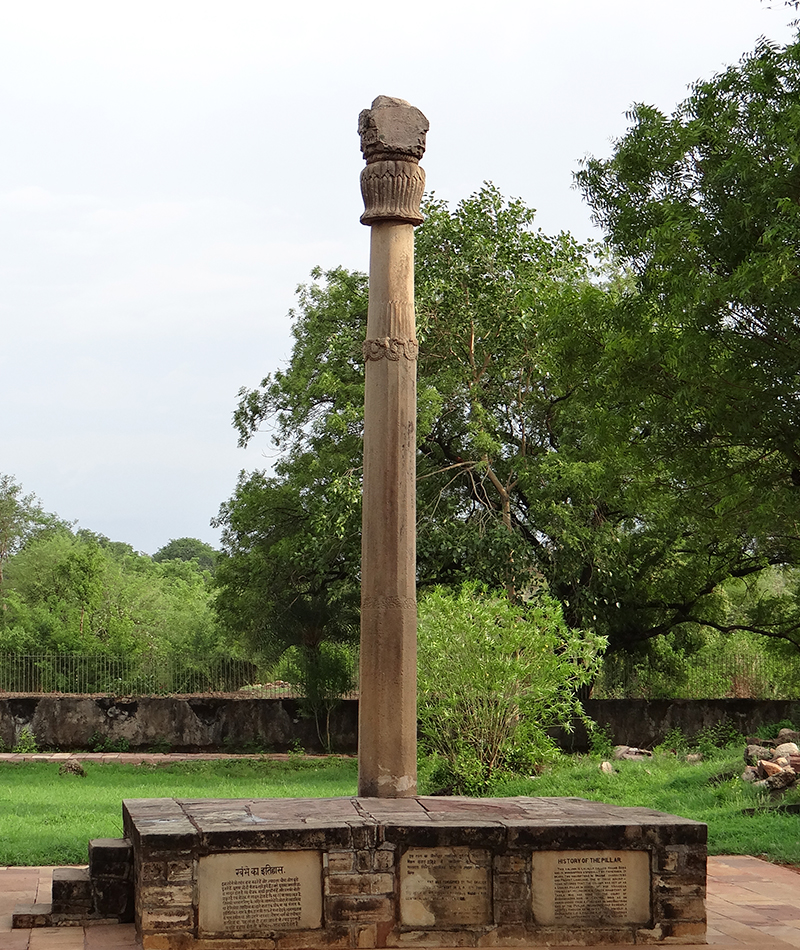A free-standing, sandstone pillar measuring 6.5 metres in height, the Heliodorus Pillar is situated at the site of Besnagar (in present-day Vidisha, Madhya Pradesh) at the confluence of the rivers Bes and Betwa. The pillar contains two sets of inscriptions that describe the circumstances of its construction under the patronage of the Indo-Greek ambassador Heliodorus in the early second century BCE. It is dedicated to Vaishnava religious practices and is considered to be historical evidence of trade and diplomatic relations between the Indo-Greek kingdom centred around Taxila in modern-day Pakistan, and the kingdoms of the Gangetic Plains.
The pillar’s shaft is divided into three segments crowned by a decorated but heavily damaged abacus. The lower, middle and upper segments have eight, sixteen and thirty-two sides respectively, with the upper being the shortest. The border between the lower and middle segments is decorated with a carved ring of low relief floral half-medallions. The middle and upper segments are in turn separated by a mid-relief garland of entwined vines looped around honeysuckle flowers and fruits, and held up by pairs of geese. Above the upper segment is a smooth cylindrical segment surmounted by the capital, which consists of an upturned bell-shaped lotus base and a damaged cubical abacus that seems to have featured animal motifs, possibly mythical birds and hybrid creatures. The inscriptions suggest that a sculpted figure of Garuda in an earlier, less anthropomorphic form may have surmounted it. The lime mortar base of the pillar presents one of the earliest pieces of evidence of cement binding in India.
The lower segment of the shaft bears two sets of inscriptions, each written across three faces on opposing sides of the pillar. These inscriptions were concealed under thick layers of vermillion when the structure was examined by Alexander Cunningham and other archaeologists in 1877, suggesting that it had become an object of local devotion. Before the inscriptions were uncovered, the pillar initially was dated to the fourth century and assumed to have been part of a Gupta era building. The inscriptions are written in the Brahmi script, although the language is Prakrit. The mention of a garudadhavaja (Garuda standard) — one of the earliest such references found in India — in the first set, and the presence of a Vishnu shrine nearby, distinguishes it from the earlier Ashokan pillars and marks it as an early monumental conception of Brahmanical religions. Scholars have suggested that it may have formed a part of a group of eight free-standing pillars dedicated to the shrine.
The first set of inscriptions identifies Heliodorus as a Bhagavata and as an ambassador sent by the Indo-Greek king Antialcidas to the court of the Shunga king Bhagabhadra. The second set, inscribed on the other face of the pillar, offers advice on the path to immortality, recommending self-control, self-denial and watchfulness. Due to his description as a Bhagavata, Heliodorus is believed to have been an adherent of a Vaishnava cult, although some scholars have suggested that it could equally refer to the Buddha, who was also referred to as Bhagavan (The Blessed One) by his followers. The pillar has been understood as an aniconic symbol of Vasudeva, (considered Krishna’s father in later traditions). Vasudeva may have been represented here as embodying cosmic totality, with the three distinct levels of the pillar standing in as an axis that joins the earth, the intermediate space and the heavens.
The pillar is locally known as Khambh Baba, meaning The Pillar Saint, or Father, and is occasionally worshipped. It is under the protection of the Archaeological Survey of India.







